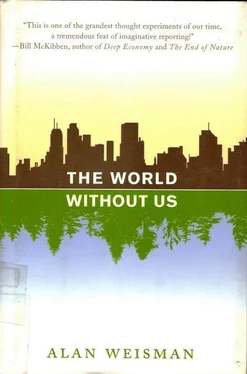The other hitch is that even though a ghost fishnet made from photodegradable plastic might disintegrate before it drowns any dolphins, its chemical nature will not change for hundreds, perhaps thousands of years.
“Plastic is still plastic. The material still remains a polymer. Polyethylene is not biodegraded in any practical time scale. There is no mechanism in the marine environment to biodegrade that long a molecule.” Even if photodegradable nets helped marine mammals live, he concluded, their powdery residue remains in the sea, where the filter feeders will find it.
“Except for a small amount that’s been incinerated,” says Tony Andrady the oracle, “every bit of plastic manufactured in the world for the last 50 years or so still remains. It’s somewhere in the environment.”
That half-century’s total production now surpasses 1 billion tons. It includes hundreds of different plastics, with untold permutations involving added plasticizers, opacifiers, colors, fillers, strengtheners, and light stabilizers. The longevity of each can vary enormously. Thus far, none has disappeared. Researchers have attempted to find out how long it will take polyethylene to biodegrade by incubating a sample in a live bacteria culture. A year later, less than 1 percent was gone.
“And that’s under the best controlled laboratory conditions. That’s not what you will find in real life,” says Tony Andrady. “Plastics haven’t been around long enough for microbes to develop the enzymes to handle it, so they can only biodegrade the very-low-molecular-weight part of the plastic”—meaning, the smallest, already-broken polymer chains. Although truly biodegradable plastics derived from natural plant sugars have appeared, as well as biodegradable polyester made from bacteria, the chances of them replacing the petroleum-based originals aren’t great.
“Since the idea of packaging is to protect food from bacteria,” Andrady observes, “wrapping leftovers in plastic that encourages microbes to eat it may not be the smartest thing to do.”
But even if it worked, or even if humans were gone and never produced another nurdle, all the plastic already produced would remain—how long?
“Egyptian pyramids have preserved corn, seeds, and even human parts such as hair because they were sealed away from sunlight with little oxygen or moisture,” says Andrady, a mild, precise man with a broad face and a clipped, persuasively reasonable voice. “Our waste dumps are somewhat like that. Plastic buried where there’s little water, sun, or oxygen will stay intact a long time. That is also true if it is sunk in the ocean, covered with sediment. At the bottom of the sea, there’s no oxygen, and it’s very cold.”
He gives a clipped little laugh. “Of course,” he adds, “we don’t know much about microbiology at those depths. Possibly anaerobic organisms there can biodegrade it. It’s not inconceivable. But no one’s taken a submersible down to check. Based on our observations, it’s unlikely. So we expect much-slower degradation at the sea bottom. Many times longer. Even an order of magnitude longer.”
An order of magnitude—that’s 10 times—longer than what? One thousand years? Ten thousand?
No one knows, because no plastic has died a natural death yet. It took today’s microbes that break hydrocarbons down to their building blocks a long time after plants appeared to learn to eat lignin and cellulose. More recently, they’ve even learned to eat oil. None can digest plastic yet, because 50 years is too short a time for evolution to develop the necessary biochemistry.
“But give it 100,000 years,” says Andrady the optimist. He was in his native Sri Lanka when the Christmas 2004 tsunami hit, and even there, after those apocalyptic waters struck, people found reason to hope. “I’m sure you’ll find many species of microbes whose genes will let them do this tremendously advantageous thing, so that their numbers will grow and prosper. Today’s amount of plastic will take hundreds of thousands of years to consume, but, eventually, it will all biodegrade. Lignin is far more complex, and it biodegrades. It’s just a matter of waiting for evolution to catch up with the materials we are making.”
And should biologic time run out and some plastics remain, there is always geologic time.
“The upheavals and pressure will change it into something else. Just like trees buried in bogs a long time ago—the geologic process, not biodegradation, changed them into oil and coal. Maybe high concentrations of plastics will turn into something like that. Eventually, they will change. Change is the hallmark of nature. Nothing remains the same.”
CHAPTER 10

The Petro Patch
WHEN HUMANS DEPART, among the immediate beneficiaries of our absence will be mosquitoes. Although our anthropocentric worldview may flatter us into thinking that human blood is essential to their survival, in fact they are versatile gourmets capable of supping at the veins of most warm-blooded mammals, cold-blooded reptiles, and even birds. In our absence, presumably plenty of wild and feral creatures will rush to fill our void and set up house in our abandoned spaces. Their numbers no longer culled by our lethal traffic, they should multiply with such abandon that humanity’s total biomass—which the eminent biologist E. O. Wilson estimates wouldn’t fill the Grand Canyon—won’t be missed for long.
At the same time, any mosquitoes still bereaved by our passing will be consoled by two bequests. First, we’ll stop exterminating them. Humans were targeting mosquitoes long before the invention of pesticides, by spreading oil on the surfaces of ponds, estuaries, and puddles where they breed. This larvicide, which denies baby mosquitoes oxygen, is still widely practiced, as are all other manners of antimosquito chemical warfare. They range from hormones that keep larvae from maturing into adults, to—especially in the malarial tropics—aerial spraying of DDT, banned only in parts of the world. With humans gone, billions of the little buzzers that would otherwise have died prematurely will now live, and among the secondary beneficiaries will be many freshwater fish species, in whose food chains mosquito eggs and larvae form big links. Others will be flowers: when mosquitoes aren’t sucking blood, they sip nectar—the main meal for all male mosquitoes, although vampirish females drink it as well. That makes them pollinators, so the world without us will bloom anew.
The other gift to mosquitoes will be restoration of their traditional homelands—in this case, home waters. In the United States alone, since its founding in 1776, the part of their prime breeding habitat, wetlands, that they have lost equals twice the area of California. Put that much land back into swamps, and you get the idea. (Mosquito population growth would have to be adjusted for corresponding increases in mosquito-eating fish, toads, and frogs—though, with the last two, humans may have given the insects yet another break: It’s unclear how many amphibians will survive chytrid, an escaped fungus spread by the international trade in laboratory frogs. Triggered by rising temperatures, it has annihilated hundreds of species worldwide.)
Habitat or not, as anyone knows who lives atop a former marsh that was drained and developed, be it in suburban Connecticut or a Nairobi slum, mosquitoes always find a way. Even a dew-filled plastic bottle cap can incubate a few of their eggs. Until asphalt and pavement decompose for good and wetlands rise up to reclaim their former surface rights, mosquitoes will make do with puddles and backed-up sewers. And they can also rest assured that one of their favorite man-made nurseries will be intact for, at minimum, another century, and will continue making cameo appearances for many more centuries thereafter: scrapped rubber automobile tires.
Читать дальше












